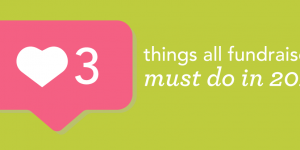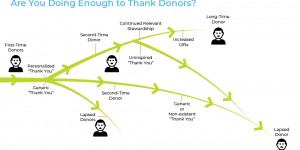With many fundraisers looking ahead toward fall and planning their strategies for raising serious end-of-year dollars, it’s easy to let tangible goals slip away in an effort to capture as many gifts from as many places possible. Going into the busiest fundraising season with a clear objective is key to generating the support necessary to sustain your organization for years to come. In other words, a focus on donor loyalty is oftentimes more important than raising a specific dollar amount. The more loyal supporters an organization has in its back pocket, the more significant the support raised over time.
Initially, you might think that building a strong donor base means acquiring lots and lots of donors. While there is a time and place for acquisition, it’s important to pick the right battles. Lapsed donors can sometimes be your best prospects. Why? They already know you and they’ve expressed interest in your work in the form of a gift. If you’ve got a limited budget to begin with, engaging with people with a higher chance of responding versus the increased effort of making a connection with strangers may perhaps be one of the fiscally responsible decisions you can make this year.
So with that in mind, let’s look at some ways to reactivate lapsed donors:
- Make it Feel Personal
The first thing to keep in mind is that when communicating with lapsed donors, you’re communicating with a friend. Save the lofty wording for the grants or acquisition mailings. Appeals to lapsed donors should be casual, concise, and should encourage the reader to recall the impact their support has made in the past and can make again. Even if they haven’t given in a while, they should still feel like a hero. Also, if they already know you then you should demonstrate that you really know them.
Try out the following things:
• Use handwriting or handwritten fonts where possible for a personal feel
• Include a prepaid reply envelope to make it even easier to give again
• Reference specific areas of past support if you know them, and illustrate those points with pictures
2. Be Specific with the Ask
In the case of renewing lapsed donors, response is more important than the dollar amount raised. This is not the time to upgrade from their last gift. On your reply card or in your appeal, reference their last gift amount. You can ask for the same gift, or create a variable ask string that provides a range of options close to the amount of their last donation. For all intents and purposes, your relationships with lapsed donors are once again in their infancy. Slowly work your way up to a larger gift, since it’s likely that if they respond to this appeal they’ll be on track to receive another ask later on in the year.
3. Have a Plan for Stewardship
In Blackbaud’s Next Generation of American Giving we learned that donors cite the unending ask as one of the top reasons why they stopped giving, which reinforces the importance of adequate stewardship—especially in the case of reactivating lapsed donors! Have a stewardship plan in place for all of your donors before you begin your appeal campaign. With your LYBUNTs and SYBUNTs, you might consider investing in the development of a welcome kit that includes a letter of gratitude, some new information about your organization, or even a small gift. While many nonprofits weave a second ask into their stewardship communications, particularly within 6 months of receiving a gift, it’s recommended that this step be skipped for those getting reacquainted with your organization.
Instead, keep the following things in mind:
• Be prompt with your thank you communications
• Remind them of why they gave versus what they gave
• Offer new ways to get involved to maintain a high level of engagement
4. Pace Yourself
It’s great to be a proactive fundraiser, but with this group of people you needn’t be aggressive. Take a step back and look at your appeal calendar and identify the big milestone asks. Beyond your end of year appeal, you may have a spring campaign, an end of fiscal year campaign, not to mention special events. For those who are just again swimming in the shallow end of the giving pool, be mindful of your solicitation frequency. Figure out which campaigns are of the greatest importance and slowly ease them into deeper waters. For instance, if a lapsed donor reactivates during your fall campaign, consider suppressing them from a Giving Tuesday push or end of year ask. Spend this time making sure they’re hearing about the impact they’ve made, not just how valuable you think their checkbook is.
The Wrap Up
What the big picture looks like is that not all donors are the same, which means that the ways in which you direct appeals and messaging toward them have to be different. Personalizing communications and applying variable techniques both in direct mail and email will go a long way toward positively impacting and growing a base of loyal donors. After all, donors are individuals and you have to treat them as such. Before you jump back on the fundraising freeway in a month or two, take a good hard look at your data. Begin by segmenting your list by constituency, and consider simple techniques that allow you to address the different types of donors in a way that encourages a response. Remember, some of the biggest donors with the highest lifetime value started by giving $10.
You Might Also Enjoy:
+ 4 Keys to Meaningful Donor Stewardship
+ Integrated Marketing and Your Donor Base
+ Understanding a Campaign Flow
Like what you see? Stay in touch!












